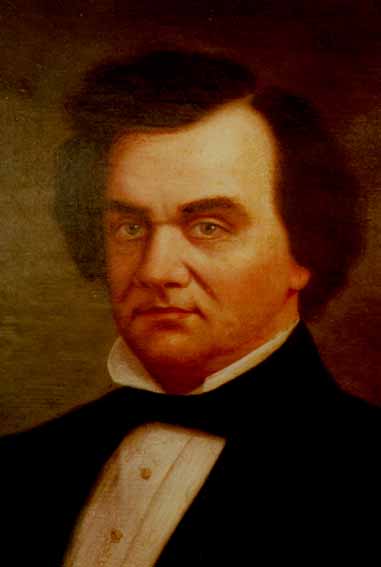
Douglas, Stephen A. (Douglass)
b. April 23, 1813, in Brandon, Vermont; d. June 3, 1861, in Chicago, Illinois. Douglas and his family settled in upstate New
York in 1830. Douglas attended the Canandaigua Academy before leaving in 1833 to
study law with a local attorney. In November 1833, Douglas moved to Jacksonville, Illinois, but soon moved to Winchester,
Illinois, after receiving a schoolmaster position. The following spring, he returned to Jacksonville and received his law
license.
In 1835, the general assembly appointed him as state's attorney for the First Judicial Circuit. He also became involved in
Democratic party politics. Voters elected Douglas to the state legislature in 1836, and in the same year, he accepted the
position
of Register of the Land Office in Springfield, Illinois. After losing a bid for the United States House of Representatives
against
John T. Stuart in 1837, he became chairman of the Democratic State Committee and effectively the manager of the Democratic
Party
in Illinois.
In 1840, Douglas was appointed Secretary of State and used his position to lobby for an expansion of the Illinois Supreme
Court.
In 1841, the legislature expanded the supreme court from four to nine members and appointed Douglas as one of the five new
justices. At the age of twenty-seven, he became the youngest person to have served on that court. The legislature divided
Illinois
into nine judicial circuits with each supreme court justice presiding over a circuit, and Douglas was responsible for the
Fifth
Judicial Circuit. In 1843, voters elected Douglas to the United States House of Representatives where he advocated a strong
expansionist policy and twice won reelection.
In 1847, the Illinois General Assembly elected Douglas to the United States Senate, where he became Chairman of the Committee
on
Territories. He moved to Chicago that same year and invested in area real estate. It was largely through his efforts that
the
Illinois Central Railroad, which ran from Galena to Cairo, expanded to link Chicago with Mobile, Alabama. In dealing with
the
sectional controversy over how to regulate slavery in the territories, Douglas articulated the principle of "popular sovereignty."
This attempt at a compromise on the slavery issue ultimately contributed to the division of the Democratic party. In 1858,
he won
reelection to the United State Senate over his opponent Abraham Lincoln. This heated campaign included the famous Lincoln-Douglas
Debates that gave Lincoln national recognition. In 1860, Douglas ran against Lincoln for the Presidency. However, the Democratic
party split. Democrats in northern states generally voted for Douglas, while those in southern states voted for John C.
Breckinridge. After the election, Douglas served on the Committee of Thirteen and supporting the ill-fated Crittenden resolution
in an attempt to save the Union. He voiced his support for the Lincoln administration, and on April 25, 1861, he delivered
one of
his most famous pro-Union speeches in Springfield, Illinois, at the state capitol building. He contracted typhoid fever and
died
shortly thereafter.
Usher F. Linder, Reminiscences of the Early Bench and Bar of Illinois (Chicago: Chicago Legal News Company,
1879), 76-82; John Palmer, ed., The Bench and Bar of Illinois: Historical and Reminiscent (Chicago: Lewis
Publishing Co., 1899), 1:37-38; Albert A. Woldman, Lawyer Lincoln (Boston and New York: Houghton Mifflin Company,
1936); John J. Duff, A. Lincoln: Prairie Lawyer (New York: Bramhall House, 1960); Allen Johnson, ed.,
Dictionary of American Biography (New York: Charles Scribner’s & Sons, 1964), 3:1:397-403; Robert W.
Johannsen, Stephen A. Douglas (New York: Oxford University Press, 1973); Mark E. Neely Jr., The Abraham
Lincoln Encyclopedia (New York: McGraw Hill, 1982), 84-88; Allen Johnson, Stephen A. Douglas (New
York: Chelsea House, 1983); Robert W. Johannsen, The Frontier, the Union, and Stephen A. Douglas (Urbana:
University of Illinois Press, 1989); John A. Garraty and Mark C. Carnes, eds., American National Biography (New
York: Oxford University Press, 1999), 6:805-8. Illustration courtesy of the Abraham Lincoln Presidential Library,
Springfield, IL.